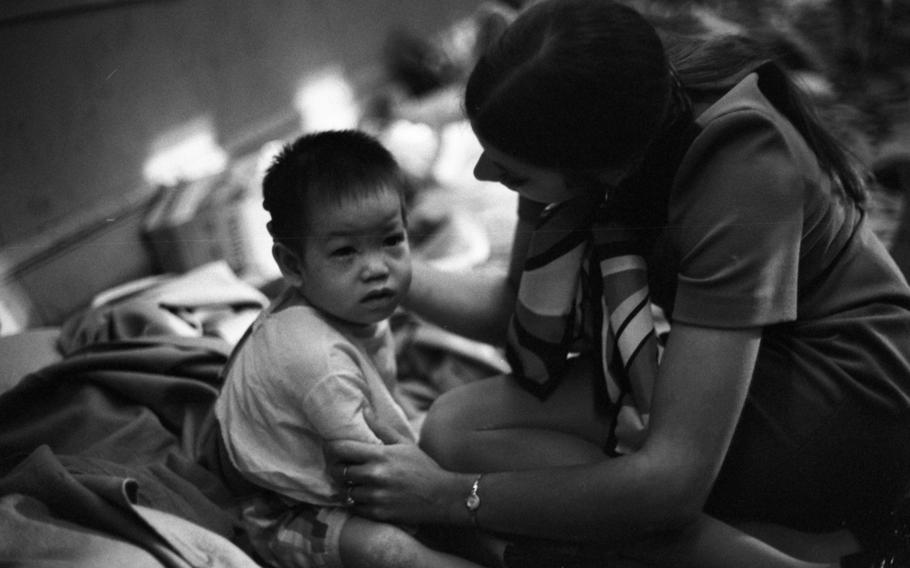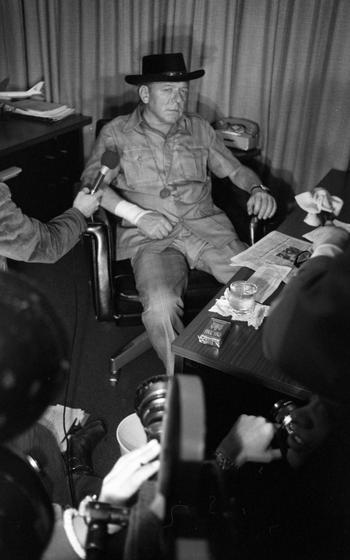History
From the Archives: The Freedom Bird Flies Again
Stars and Stripes Staff Writers and AP, UPI April 2, 2025

Am unidentified woman comforts a child aboard the World Airways plane. The plane left Saigon's Tan Son Nhut Airport Apr. 2, 1975 with 54 Vietnamese orphans aboard. (Bob Wickely/Stars and Stripes)
This article first appeared in the Stars and Stripes Pacific edition, April 4, 1975. It is republished unedited in its original form.
TOKYO — The first refugees out of Saigon — 54 Vietnamese orphans — arrived at Yokota AB early Thursday after a dash to freedom from an increasingly nervous South Vietnamese capital.
The children, ranging in age from three months to three years, were loaded onto a World Airways DCS jet in Saigon late Wednesday night [April 2, 1975] and headed away on a 25-hour journey to the United States, even though the control tower at Tan Son Nhut Airport ordered pilot Ken Healy: “Don’t take off, don’t take off, you have no clearance!”
Healy, who flew refugees out of the rapidly falling Mainland China in the late 1940s, smiled afterward and said: “I just didn’t get the message in time.”
Just before the jet took off, Saigon airport had been closed because of a feared Viet Cong attack, and all nonmilitary people were ordered off the air base.
More than 400 orphans were to be on the jet but according to Ed Daly, the colorful company president who last Saturday made a dramatic trip to Da Nang to snatch refugees from the airport, the U.S. Embassy interfered in his plans and advised Saigon orphanages not to fly in his plane.

World Airways president Ed Daly holds court in front of reporters and cameramen at Yokota Air Base in Japan on April 3, 1975. (Bob Wickley/Stars and Stripes)
Daly said the embassy would not okay the way he had configured his cargo plane to carry the large number of children.
Asked about the truth of statements made by others on the plane that 450 children had been slated for the flight but were pulled off at the last minute by organizations pressured by U.S. Agency for International Development (US AID), and statements that the plane was unsafe and unsanitary, Daly said, “I’m emotionally upset but am fully aware of what I will say.”
“Yes.”
Daly appeared too drawn and tired to repeat sharp accusations he made earlier in Saigon. He said there that the U.S. Embassy vindictively tried to block the orphan flight because he flew into Da Nang without clearing with embassy officials.
Daly said the DCS “stretch” aircraft was completely safe.
“This aircraft was certified by the FAA,” he said. “When we put the rigging in, it’s 20 to 30 per cent safer than normal seating.
“Besides, the U.S. AID man who supposedly inspected it — Clifford Frink — was never on the aircraft,” he added.
Daly had charged in Saigon that AID officials had called his plane dangerously overloaded and said it had no toilets.
Charles J. Patterson, also a senior vice president and director, called the charges, “Balderdash! We had four Johns on the plane.”
Valerie Witherspoon, a stewardess on the five-hour flight from the Vietnamese capital, said she packed enough food and other supplies for the 450 children expected to make the flight to Oakland.
She said , however, The Friends of All Children in Vietnam pulled back a large number of orphans because of the USAID charges.
“The theory was that the aircraft was being operated without seats, making it unsafe for the flight,” said Brian A. Cooke, senior vice president and director of the airline. “All the children were laid on blankets and pillows and were held in safe positions with cargo straps. It was the safest way to carry them.”
Joe Hrezo, manager for the airline at Clark AB, R.P., said after gently lying an infant on a blanket, “They’re full of — !”
Hrezo also charged seven agencies had readied children for the flight but placed only a fractional number aboard after the USAID charges were made.
One World official said all the eyed as spotlights and flash children aboard had already been spoken for by American families. Others on the flight said, however, adoption proceedings have not been started for all the youngsters.
Besides the children, 17 World Airways employes and two doctors were on the flight, which arrived here at 3:12 a.m.
“They were very excited about the lights of Saigon as we took off, and those still awake when we came in ran to the windows to see the lights of Tokyo.
It was their bedtime and most slept soundly through the flight,” a crewmember said.
At Yokota many children slumbered on blankets and pillows in the cavernous cargo van of the DC8. Others sat up bewilderedly and stared wide-eyed as spotlights and flashbulbs glared at them. Some ran around inside the plane and chattered in sharp, shrill, Vietnamese, smiling and pulling at airline and Air Force officials and spreading their arms in a silent appeal to be picked up. Only one or two cried.
“Most of them were affectionate and happy,” Miss Witherspoon said, describing the flight. “A few were sad though. We never could get them to crack a smile. We’re still working on it.”
Among those on the plane was Mrs. Mary Fisher, the wife of a Seventh Day Adventist Church minister, who was carrying six babies, three of them for clients of Hollywood lawyer Durand Cook. One of the toddlers with Mrs. Fisher was 11-month-old Wendy Carol Norberg, who has been adopted by Mr. and Mrs. Harold Norberg of Los Angeles. Mrs. Fisher said the Norbergs probably are not aware that their adopted daughter has managed to get out of Saigon.
Two infants — a boy and a girl — tightly wrapped in blankets were taken from the plane at Yokota by Dr. Gene Hildebrand, from the Seventh Day Adventist Hospital in Saigon, and Dr. Elaine Shankel, from the Saigon Infant Hospital.
Both babies were suffering “from a number of things, all of which start with malnutrition,” the doctors said. They were taken to the U.S. Air Force Hospital at Tachikawa AB for treatment.
Japanese immigration restrictions kept the rest of the children inside the plane, but the two who were treated were allowed off under emergency provisions of the law.
“The main thing we’re worried about is that they haven’t taken any liquid during the flight and they’re dehydrated,” the doctors said.
World Airways officials here loaded 10 cases of baby food, several cases of prepared formula, 400 more diapers, 80 cardboard bassinets” and medical supplies, particularly remedies for malnutrition, aboard the plane for the rest of the flight to California.
An airline employe said the DC8 was the same one which had been damaged earlier during a rice run into Phnom Penh. He said the plane had been repaired and had been slated to return to Oakland empty until Daly personally ordered it to Saigon to pick up the orphans.
Daly told newsmen in an airport press conference that he was prepared to personally absorb “every dollar of expense” for the $70,000 trip.
Earlier reports from Saigon were that the DCS was to take 1,000 children to the United States and a 747 aircraft was to take 500 to Australia. Australian government officials, however, refused clearance for the children to be brought into the country.
When newsmen here told Patterson that Australia reportedly was sending seven airplanes to Vietnam for refugee relief, he said, “I’m glad to hear that.”
Daly arrived here with his right hand in bandages. Hrezo said the hand had been injured at Da Nang when Daly was pulling him from a mob of hysterical South Vietnamese soldiers and airmen attempting to crowd onto the last flight from the city. He called them “wild beasts.” On that last flight from Da Nang we watched women and children stomped to death by the soldiers. I only hope that doesn’t happen to those kids left behind,” he said.
The DCS left Yokota at 5:45 a.m. for the nonstop flight to Oakland.
Daly remained in Tokyo “for a day or so of rest.”